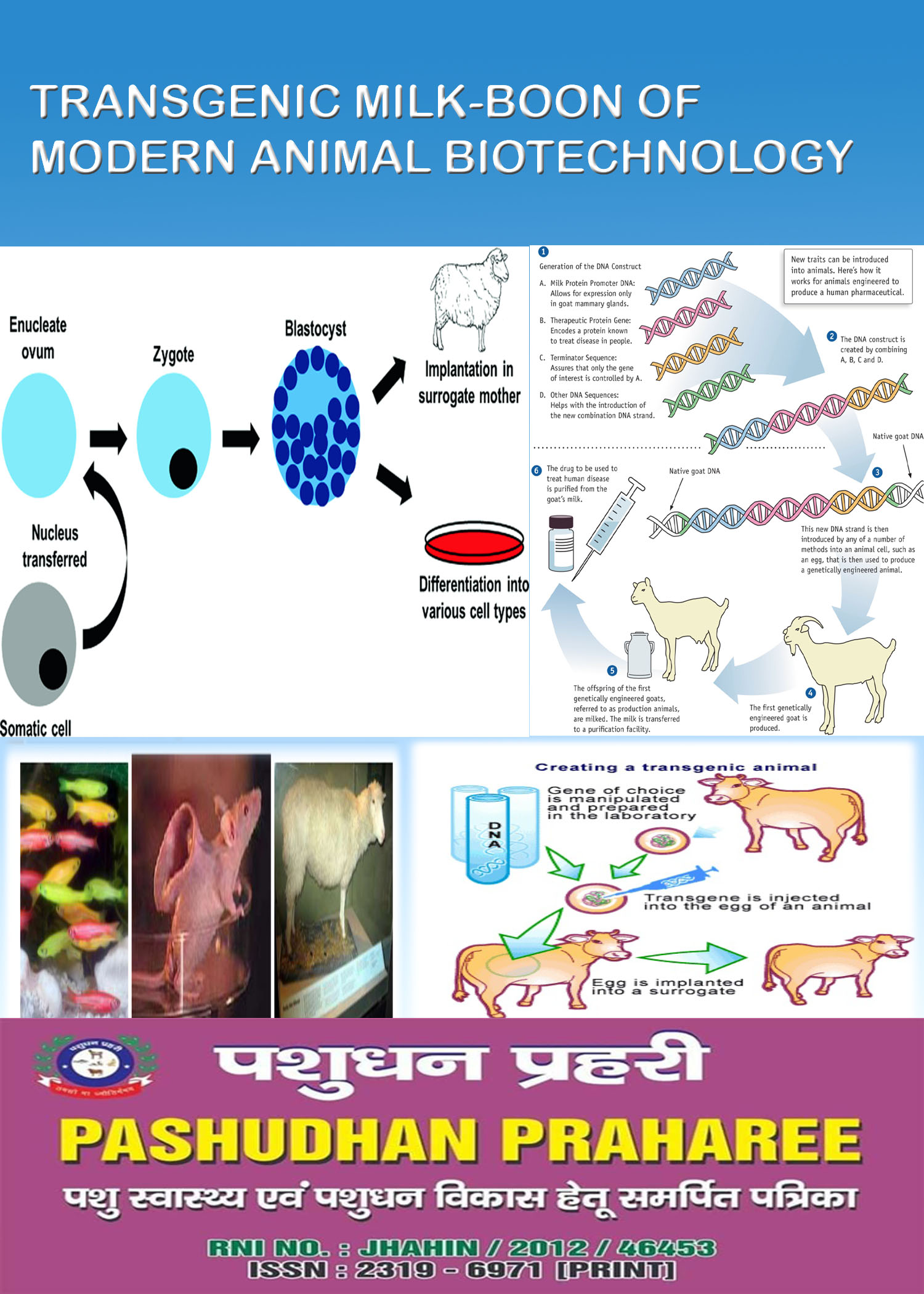TRANSGENIC MILK-BOON OF MODERN ANIMAL BIOTECHNOLOGY
COMPILED & Edited BY –DR. RK SINGH, JAMSHEDPUR, & DR. RAJIV KUMAR, SCIENTIST, ICAR, AVIKANAGAR
Introduction
Over centuries animal breeding practices were
performed to improve the genetic potential of animals
and to introduce new traits, through genetic selection.
But the number of gene combinations achieved through
this process has limitations, since breeding is only
possible between animals of same or closely related
species. Transgenesis is a revolutionary technology
which introduces new genes to a species, which belong
to an entirely different species. The chemical
combination of DNA is same in all eukaryotic species.
Theoretically genes can be transferred between any
species. So the resulting species will be having the
desired characteristics of another species. Result of
human genome project and other similar projects to
reveal the genetic code has opened new arenas in
medical research in combination with transgenics.
Gene Pharming
By genetic engineering, the gene for a protein drug of interest can be transferred into another organism that will produce large amounts of the drug. Transgenic technology led to the emergence of a new kind of farming from research and development labs of several universities and small biotechnology companies- they even changed the spelling to “pharming”. “Pharming” is the production of human pharmaceuticals in farm animals.
Gene “Pharming” enables production of
recombinant biologically active proteins in the
mammary glands of transgenic animals. This
technology overcomes the limitations of conventional
and recombinant production system for pharmace-
utical proteins. Mammary gland is the preferred
production site, mainly because the qualities of protein
that can be produced in this organ using mammary
gland specific promoter elements and established
methods for extraction and purification of that proteins.Numerous monoclonal antibodies are being
produced in the mammary gland of transgenic goats.
Cloned transgenic cattle can produce a recombinant for all organisms, the fine details of gene control differ. A gene from a bacterium will not often work correctly if group it is introduced unmodified into a eukaryotic animal cel
The genetic engineer first of all constructs a transgene containing the gene of interest plus some extra DNA Now that correctly controls the function of the gene in the new animal. This transgene has then to be inserted into a new animal. Many genes are only expressed in particular tissues and are controlled by special segment of DNA next to the gene called promoter sequence more When constructing a transgene, scientists generally substitute the donor’s promoter sequence with one that is specially designed to ensure that the gene will began function in the correct tissues of the recipient animal This is crucial when, for example the gene need to be expressed in milk of animal
Transgenic Animals and Milk
though, Milk-producing transgenic animals are especially useful for production of medicines, nutritional
supplements and pharmaceuticals. Products such as insulin, growth hormone, and blood anti-clotting factors have already been obtained from the milk of transgenic cows, sheep, or goats. Research is also underway to manufacture milk through transgenesis for treatment of debilitating diseases such as phenylketonuria (PKU),
hereditary emphysema, and cystic fibrosis. Milk composition can be altered in several ways- changing the concentration of unsaturated fatty acids reducing the lactose content, removing ß- lactoglobulin and combining nutraceuticals in milk. By combining nutritional and genetic interventions, researchers are milk components that have implications in health as well as treatment. Cows, goats and sheep are utilized for the production of more than 60 therapeutic proteins including plasma proteins, monoclonal antibodies and vaccines. In 1997, the first transgenic cow, Rosie, produced human alpha-lactalbumin -enriched milk at
2.4 grams per litre. This transgenic milk is a more nutritionally balanced product than natural bovine milk
and could be given to babies or the elderly with special nutritional or digestive needs Lactoferrin, the iron-binding protein plays an important role in stimulating the immune system and acting as a first line of defence against infection. Its level in human milk is about 1 g/l (in human colostrum160 about 7 g/l) and that in cow’s milk is only about one- tenth that in human milk. A New Zealand research developed a genetically modified dairy herd capable
of producing ‘medicinal milk’ containing recombinant human lactoferrin (rhLF) by transgenic technology. Argentinean scientists have developed a cow which can secrete human insulin in its milk. This insulin will be purified from cow milk and used for treatment of Diabetes Mellitus. When compared to conventional methods of insulin production this method is much cost effective. In 2001, two scientists in Canada spliced spider genes into the cells of lactating goats. The goats to manufacture silk along with their milk and secrete tiny silk strands from their body by the bucketful. By extracting polymer strands from the milk and weaving them into thread, the scientists can create a light, flexible material that could be used in such applications as military uniforms, medical micro sutures, and tennis racket str ings. The major advantage of transgenic technology is that proteins can be produced at a low cost compared to the method using mammalian cell culture. However various ethical, legal and social aspects of biotechnological research need to be addressed before the implementation of transgenic herds.


